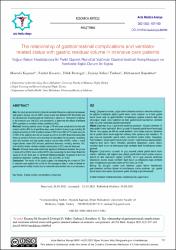| dc.contributor.author | Kaçmaz, Mustafa | |
| dc.contributor.author | Şahin Kocaöz, Fazilet | |
| dc.contributor.author | Destegül, Dilek | |
| dc.contributor.author | Yüksel Turan, Zeynep | |
| dc.contributor.author | Bayraktar, Muhammet | |
| dc.date.accessioned | 2022-09-29T08:08:21Z | |
| dc.date.available | 2022-09-29T08:08:21Z | |
| dc.date.issued | 2021 | en_US |
| dc.identifier.uri | https://dergipark.org.tr/tr/download/article-file/1535732 | |
| dc.identifier.uri | https://hdl.handle.net/20.500.12868/1712 | |
| dc.description.abstract | Aim: Our study aimed primarily to determine whether there was a relationship between
total gastric residual volume (GRV) amounts and two different GRV thresholds and
the development of gastrointestinal intolerance in patients on mechanical ventilation
in the intensive care unit (ICU) and secondarily, to determine the effects of different
GRV quantities on ventilator-related conditions (VAC).
Methods: Seventy patients above the age of 18 who were scheduled to be fed with
enteral nutrition (EN) for at least three days, were divided into two groups including 35
patients according to GRV threshold values of 250 ml and 500 ml. The total amounts
of GRV of the patients who did not exceed any of the two GRV thresholds during the
follow-up period of 72 hours were recorded and calculated. For all patients, necessary
data was recorded and high gastric residual volume rates (HGRV), times to reach
target calories, mean GRV amounts, abdominal distension, vomiting, diarrhea, VAC
and infection-related ventilator-related complications (IVAC) were all observed.
Results: Although there were statistically significant differences between the groups
in terms of the HGRV rates and the HGRV rates exceeding the determined threshold
values [p <0.05], there was no significant difference between the groups in terms of
abdominal distension, vomiting, diarrhea, VAC and IVAC (p> 0.05).
Conclusion: The results of this study suggest that measuring the amount of GRV
in intensive care patients fed by EN via the nasogastric tube in order to decide on
gastrointestinal motility function and to reduce the complication rate, is not necessary. | en_US |
| dc.language.iso | eng | en_US |
| dc.publisher | Acta Medica Alanya | en_US |
| dc.relation.isversionof | 10.30565/medalanya.868948 | en_US |
| dc.rights | info:eu-repo/semantics/openAccess | en_US |
| dc.subject | Enteral nutrition | en_US |
| dc.subject | Complications | en_US |
| dc.subject | Critical care | en_US |
| dc.title | The relationship of gastrointestinal complications and ventilator related status with gastric residual volume in intensive care patients | en_US |
| dc.type | article | en_US |
| dc.contributor.department | ALKÜ | en_US |
| dc.identifier.volume | 5 | en_US |
| dc.identifier.issue | 2 | en_US |
| dc.identifier.startpage | 157 | en_US |
| dc.identifier.endpage | 163 | en_US |
| dc.relation.journal | Acta Medica Alanya | en_US |
| dc.relation.publicationcategory | Makale - Ulusal Hakemli Dergi - Başka Kurum Yazarı | en_US |


















